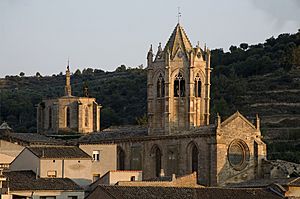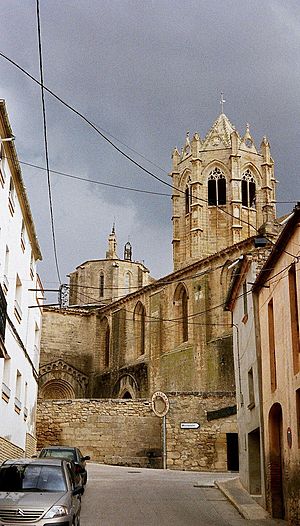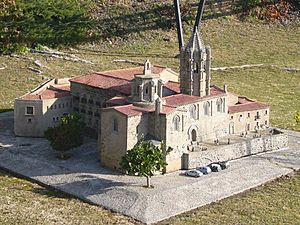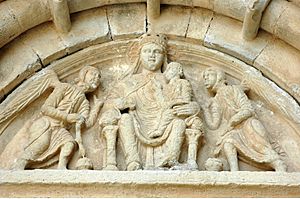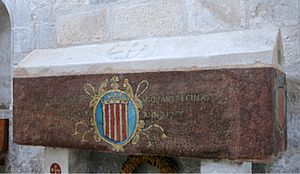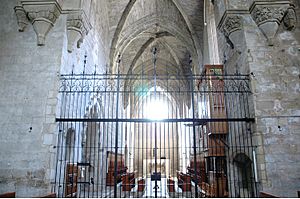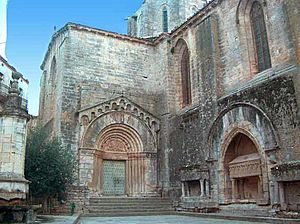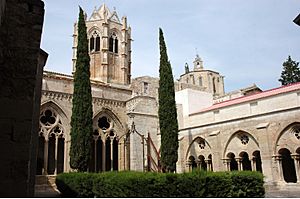Vallbona Abbey facts for kids
The Vallbona Abbey, also known as the Monastery of Santa Maria de Vallbona, is a special place where Cistercian nuns live and pray. It is located in a town called Vallbona de les Monges in Catalonia, Spain. This abbey was started in the early 1100s and was built over many years, until the 1300s. It's one of the most important old monasteries in Catalonia.
The church inside the abbey shows a mix of two old building styles: Romanesque and Gothic architecture. Because of its history and beauty, the abbey was named a national monument in Spain on June 3, 1931.
Vallbona Abbey is part of the "Cistercian Route." This route connects it with two other famous monasteries: Poblet and Santes Creus.
Contents
History of Vallbona Abbey
How the Abbey Started
The monastery began with a group of people, both men and women, who wanted to live a simple, religious life. They were called hermits. Ramon de Vallbona started this community around 1157. They followed the rules of Saint Benedict.
In 1163, the community received land as a gift from Ramon Berenguer IV, a powerful count. By 1175, only a small group of nuns remained. They decided to join the Cistercian Order, a special group of monks and nuns. The first leader, or abbess, was Oria Ramirez. She came from another abbey in Navarre in 1176.
Growing and Becoming Strong
The abbey received many special gifts and protections from King Alfonso II of Aragon and his wife Sancha of Castile. This helped the abbey grow a lot. Many rich families also gave gifts to the nuns.
Pope Innocent III gave the abbey special protection in 1198 and 1200. This meant their property was safe. In 1201, a special paper from the Pope said the nuns should stay inside the abbey. It also made the abbey independent from local bishops.
King James I of Aragon often visited the abbey. He also helped pay for its construction. Thanks to many gifts of land and money, the abbey became very powerful. It owned a lot of land, especially in the County of Urgel, between the 1100s and 1300s.
Abbess Saurena de Anglesola (1379-1392) made the abbey even stronger. She bought the right to control laws and justice in all the abbey's lands from King Peter III of Aragon. This made the monastery the main center for law and politics in its area. At this time, about 150 nuns lived there. Many of them came from important noble families in Catalonia.
The abbey had a famous library and a scriptorium. A scriptorium was a room where books were copied and decorated by hand. Fourteen old books from the 1200s, made by the nuns, are still kept there. The abbey also had a pharmacy that helped all the nearby villages. Records of this pharmacy go back to the 1400s.
Challenges and Survival
The abbey faced hard times during the Catalan civil war (1462-1472). Later, the Council of Trent (1545-1563) made a rule. It said that groups of nuns could not live in places with no people. So, in 1573, the nuns had to give away some of their land. People from other places moved there to create a town around the abbey. This is how the town of Vallbona de les Monges started. This allowed the abbey to stay in its original location.
Many of the abbey's outside buildings were changed or removed. Only the main church and cloister remained. The 1600s were also difficult. There were arguments with other Cistercian monasteries about money. Wars, like the Reapers' War (1640-1652) and the War of the Spanish Succession (1705-1717), also hurt the abbey's money.
In the 1830s, the government took control of many church properties in Spain. The nuns had to leave for six months. But they were able to return and continue their life in the monastery. Vallbona Abbey did not suffer as much damage as other monasteries like Poblet or Santes Creus.
Vallbona Abbey Today
Since then, Cistercian nuns have lived in Vallbona Abbey without stopping. The only exception was during the Spanish Civil War. Today, it is still a working monastery. Visitors can come and see it every day.
In 1986, work began to fix up the old buildings. New rooms were also built for the nuns to live and work in. This work continued in 1997. Some rooms are now used for visitors to stay overnight. The nuns also earn money by making ceramic art, doing computer work, and offering tours.
Buildings of the Abbey
The Church
The church was built between the 1100s and 1300s. It shows a mix of Romanesque and Gothic styles. It has a cross shape when viewed from above. It has one main area called a nave, with four sections. It also has a transept, which is the part that crosses the nave.
The transept is longer but narrower than the nave. A special octagonal (eight-sided) dome sits above where the nave and transept meet. The ends of the transept have square chapels. The nave has cross-shaped ceilings, while the transept has rounded ceilings.
The bell tower is octagonal and was built between 1340 and 1348. It is in the Gothic style. Inside the church, near the altar, is the tomb of Violant of Hungary. She was the wife of King James I of Aragon. She died in 1251, and her body was moved here in 1275.
To the right of the main area is the Corpus Christi Chapel. It has a colorful stone statue of the Virgin Mary. This statue was made by Guillem Seguer.
In the southern part of the church, you can find the tomb of Ferrer Alamany de Toralla, who died in 1360, and his wife Beatriz de Guimerà. Their tomb shows Ferrer dressed as a knight and Beatriz in a nun's habit. At the bottom, two angels are shown carrying souls to heaven.
Two old altar decorations from the 1300s, which were once in the Corpus Christi Chapel, are now in the National Art Museum of Catalonia. A gate separates the main part of the church from the transept.
Church Doors
The main door is on the northern side of the church. It opens onto the abbey square. This door has a rounded arch with five decorated layers called archivolts. These layers are supported by columns with leaf designs. Above the door, there is a special carved stone area called a tympanum. It shows the Virgin Mary and baby Jesus, surrounded by angels.
Another door is on the northern wall of the church. It is now blocked by a tomb. This tomb is set into an arch with a pointed shape. On the tomb, there is a special symbol from the late 1100s. This wall has five tombs in total. Four are in the Romanesque style (from the 1200s), and one is in the Gothic style. All of them have family symbols. Two of them have names: Sibil-la de Guimerà and Miquela Sasala (from 1244).
The Cloister
The cloister is a square courtyard surrounded by covered walkways. Its sides are different lengths and were built at different times, from the 1100s to the 1400s.
The oldest part, on the south side, is simple and Romanesque. It has three sections with rounded arches supported by plain columns.
The eastern side is also Romanesque (early 1200s). It has five sections with triple windows. These windows have small rose windows with designs that look like Arabic art. The tops of the columns have plant designs.
The northern side is the shortest. It has wide openings with pointed, decorative patterns in the Gothic style, from the 1300s. The western side is the newest, built in the 1400s. It shows an early Renaissance style. The tops of its columns have the family symbols of the Caldés family. Several abbesses of the monastery came from this family.
You can enter the chapter hall from the cloister through a Gothic door. This door was built in the 1300s. The chapter hall has a cross-vaulted ceiling. On the floor, there are several tomb slabs of past abbesses. There is also a white stone statue of the Virgin of Mercy, believed to be made by the sculptor Pere Johan.
See also
 In Spanish: Monasterio de Vallbona de les Monges para niños
In Spanish: Monasterio de Vallbona de les Monges para niños


